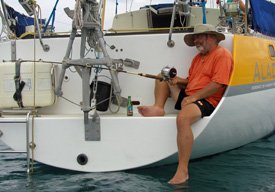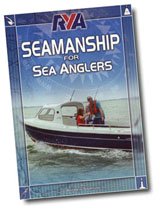- Home
- Fishing Techniques
Saltwater Fishing Techniques
for Boat and Shore Anglers
Before we get into the fascinating world of saltwater fishing techniques, I've a point to make - and it's this:~
"If ever two activities went hand in glove, it's
'messing about in boats' and saltwater fishing".
Most motorboats owners are well aware of this and get the best out of both endeavours.
But most sailboat owners? Probably not.
So for any non-fishing yachties that have stumbled across this website, I can only ask - politely of course, but firmly - Why Not? You don't know what you're missing!
So if you're a non-fishing yottie, please take a look at Secrets of Sailboat Fishing.
I do hope I can persuade you to give it a go.
 Hard work, this fishing business!
Hard work, this fishing business!As you can see, it doesn't have to be an energy intensive activity!
Now that I've got that little rant out of the way and with apologies to real boat anglers, we can get back to the saltwater fishing techniques that work, afloat and ashore.
Let's kick-off with ...
Boat Fishing Techniques
Somewhat obviously perhaps, there're three ways you can use a boat for sea angling:~
- Underway, in which case trolling is the saltwater fishing technique to use, or
- adrift, when either jigging, freelining or bottom fishing is the way to go, or
- at anchor, where bottom fishing or jigging will be your best bet
So let's get into it, starting with ...
Trolling
This involves towing a lure - or a carefully rigged deadbait - some distance astern of a moving boat. On the face of it, trolling's a simple technique, but you'll want to think about ...
- Do I need a rod and reel or will a simple handline do?
- What lure types are available, and which one should I use?
- What are the best ways of rigging natural baits for trolling?
- How far astern should the lure be?
- How deep should the lure be, and how can I get it to stay at the required depth? Do I need a paravane or a planer, or a full downrigger set up? Or should I use wire line instead of monofilament?
- What's the best trolling speed?
- How can I attract fish to my lure?
- Will deploying two trolling lines double my hit rate?
- And what's all this about the drop-back method and nose-rigging with circle hooks?
For fully illustrated answers to these questions - and more - have a look at Offshore Trolling...
Jigging
I suspect like many other sea anglers, my earliest memory of saltwater fishing was jigging for mackerel from a drifting boat whilst on the annual south coast summer holiday with my parents. Tackle was pretty basic, as was the fishing technique - a handline, a string of mackerel feathers and a sinker, which were jerked up and down experimentally at various depths.
Results were sometimes spectacular. Six or more glistening, wriggling mackerel at a time - a cause of great jubilation when you could count your age on the fingers of two hands.
Although saltwater fishing techniques haven't changed much over the years, the tackle and our aspirations have. Mackerel feathers have been largely replaced by the more effective and robust Hokkai lures, the smallest of which are the ones to use when jigging for baitfish.
Jigging is the best way of plucking individual fish from the shoals that hang out above deepwater wrecks. Perks and soft-plastic lures - muppets, shads and jellyworms - will get the job done here. Squid and octopus are also suckers (sorry) for the jig fishing technique, although they do demand specialised lures of their own.
But there's a lot more to jig fishing than jerking a lure up and down until you catch a fish or your arm drops off!
Drift fishing
As its name implies, drift fishing is done from a boat that's neither anchored nor underway, but just drifting with wind and current.
Here are a few examples where drift fishing regularly gets results:~
- In settled conditions freelining a live sandeel on the drift is a great way to nail a specimen bass;
- Plaice, flounders and other flatfish will pounce eagerly on a lugworm or ragworm baited hook as it trips seductively over a sandy seabed, drawn along by a slowly drifting boat;
- Drifting over a wreck with jigging tackle is a saltwater fishing technique that has probably produced more specimen pollack and coalfish than any other method;
- And shark anglers fish on the drift using a balloon float and whole mackerel bait, while laying out an enticingly fishy 'rubby-dubby' trail.
Read more about drift fishing techniques...
Bottom fishing
Not on the drift as previously described, but from an anchored boat.
When bottom fishing, demersal fish will again be your quarry - that is, those kinds of fish that live and feed on the sea bed, or just above it. Flatfish, skates and rays, cod, haddock and whiting for example.
At slack water, with no tidal flow to carry it astern, you'll be able to drop your baited hooks vertically to the seabed - and the paternoster rig is the one to use.
But once the tide starts to run, your paternoster rig will be lifted up and swung clear of the bottom. Not good. Time to switch to a ledger rig. Now with a running ledger weight ahead of the hook trace, you can ease out your line until the weight holds bottom and your baited hook lays on the seabed astern of it. Providing your ledger weight is heavy enough and you let out enough line, it will stay put. This is the downtide ledger fishing technique.
Uptide ledgering is a more sophisticated technique in which the rig is cast uptide and away from the boat. A wire-spiked lead will hold it in place until a fish takes, whereon the lead will be pulled free, the whole shebang will trundle off downstream and your line will go slack. Strike!
So far we've just mentioned boat fishing techniques. But not everyone likes boats. Some of my mates won't go near one unless it's safely chocked-up ashore. But then some people, inexplicably, enjoy golf.
But before we abandon fishing afloat completely and head ashore, we should think about how to find the best boat fishing marks, and the most productive times to fish them. Many boat anglers keep the best marks to themselves, so 'asking around' - even plying them with strong ale - will only get you so far.
Where and When?
If you're fortunate enough to have your own saltwater fishing boat, the ability to find the best marks for yourself is fundamental to successful boat fishing - and there's plenty of information around to help you do just that.
The 'where' part of the question can be answered by a close study of a Nautical Chart and the 'when' by reference to a set of Tide Tables and the Tidal Stream Atlas for your area.
But, just before we get into Shore Fishing ...
The sea can be a treacherous mistress and makes no allowances for beginners. All boat owners should possess an adequate level of navigation and seamanship skills, and have aboard the appropriate tide tables and other nautical publications.
Whilst it isn't within the scope of this website to get into this topic in any great detail, I must stress the importance of taking it very seriously indeed.
So if you're a boat owner and haven't yet done so, please at least get a good book on the subject - the one shown here takes some beating.
Apart from any personal considerations, you owe it to your crew.
Shore Fishing Techniques
This requires a different skill-set from those possessed by boat anglers, although several of the techniques and many of the lures, are common to both.
A primary requirement for successful shore fishing is the ability to cast well - that is, both accurately and far.
A So let's have a look at shorefishing methods:~
Surfcasting (or beachcasting)
Surfcasters need to be able to cast a bait a long way off a beach when it's necessary - although often it isn't. Bass in particular are often very close in. More than once I've been fishing a hundred yards out, only to see a sizeable bass in the shadow of my rod. Irritating...
Read these Top Ten Surf Fishing Tips!
Float Fishing
A broad fishing technique is this one, from using a balloon float far offshore for shark, to a light freshwater float fished from a harbour wall for hard-fighting mullet. But whatever the application, the float serves two purposes:~
- To present the bait at a predetermined depth, and
- To let you know when a fish has taken the bait
Baitcasting
An American term this, we'd call it spinning but our US pals do distinguish between baitcasting and spinning. The 'bait' in this case is a lure, more often than not a floating/diving plug, but spoons, shads and jelly worms are popular too. Primary targets for your saltwater baitcasting outfit will be bass, mackerel and pollack.
Read more about Baitcasting, Spinning and Plugging...
Saltwater Fly Fishing
This is a specialised saltwater fishing technique that has become increasingly popular in recent years. Wading out, waist-deep, on a gently shelving beach is normally how its done, although great results can be had from an anchored or slowly drifting dinghy.
Not though, from the deck of a sailboat - believe me, I know. If you dont want to spend most of your time removing the hook from the rigging, spars, guard rails and all the other bits that get in the way on a sailing boat, my advice is to try one of the other saltwater fishing techniques.
Here in the UK your target fish will most likely be bass, but it's in
warmer waters where this fishing technique gives the greatest sporting
rewards - bonefish, pompano, tarpon etc...
So these are the primary fishing techniques that will catch you fish.
Clearly we've only scratched the surface on this page, but if you've
followed the links you'll have found a lot more detail about each of
these fishing techniques.
Recent Articles
-
Sea Fishing Rods and Reels Must Be Compatible for a Balanced Outfit
Mar 08, 21 08:30 AM
A quality reel fitted to a quality rod doesn't necessarily make it a quality outfit. Your fishing rods and reels have to be properly matched if you're to get the best out of them, and here’s how -
Essential Lure Fishing Tips That All Saltwater Anglers Should Know
Mar 08, 21 04:51 AM
Which single lure fishing tip applies to trolling, jigging, baitcasting, spinning, fly fishing and any other branch of lure fishing? Well, it is the one at the top of this list -
Vital Jig Fishing Tips That You Really Cannot Afford To Miss!
Mar 07, 21 10:20 AM
Essential jig fishing tips to help you select the right lure for successful jig fishing, together with the techniques required to get the most out of your jig fishing outfit

























New! Comments
Have your say about what you've just read! Leave me a comment in the box below.